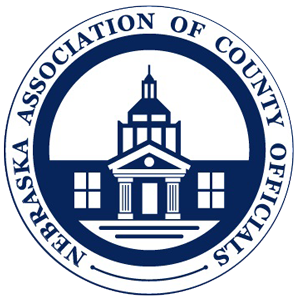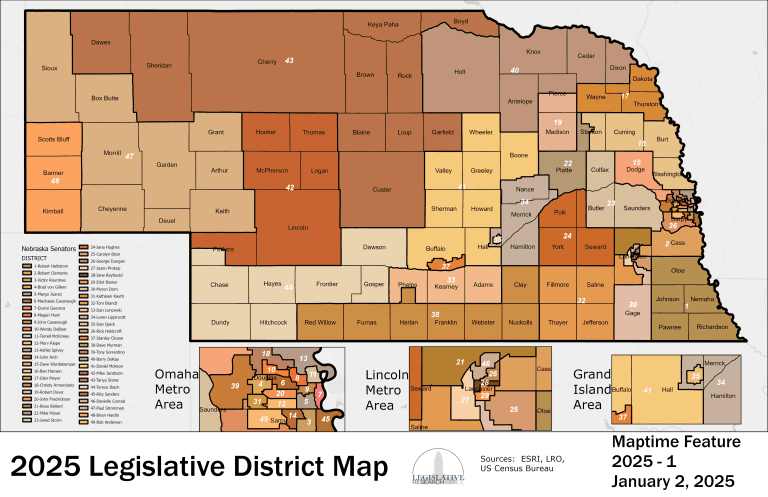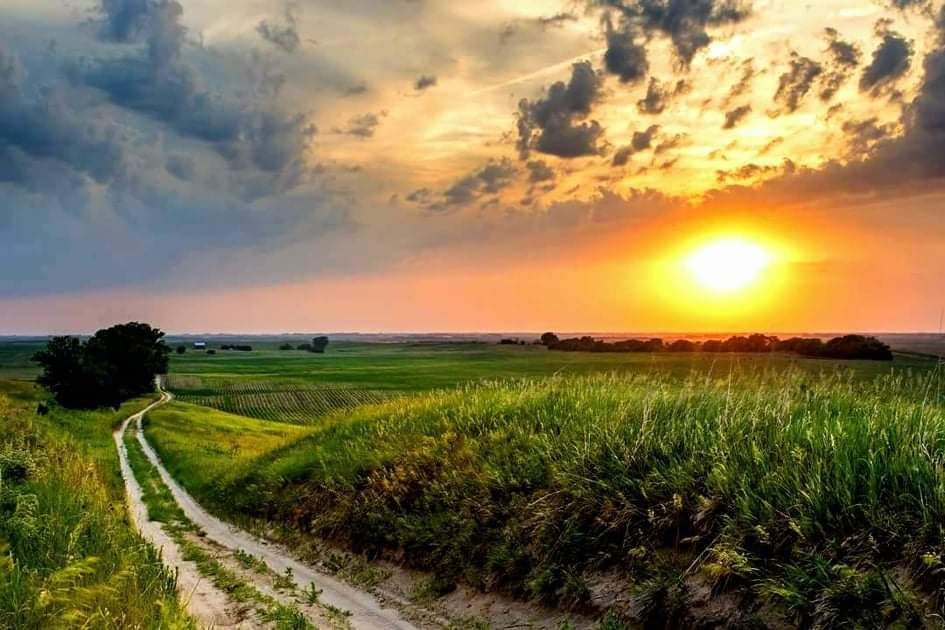- General Info
- Demographics
- Education and Employment
- Valuation and Taxes Levied
- State Senators
- History
- County Programs
- Other Information
Communities and Development
Kearney County Seat: Minden
Total County Population: 6,688
- Cities (pop. & class): Minden (3,118 • 2nd Class)
- Villages (pop.): Axtell (732), Heartwell (81), Norman (32), Wilcox (330)
- Unincorporated Pop. (% of county pop.): 2,395 (36%) 2020
Land Development (% of total land in county):
- Agriculture: 93%
- By method: Irrigated (row crop/grain/forage) (69%); Dryland (row crop/grain/forage) (13%); Pasture (pure grassland) (11%) • Neb. Dept. of Rev. - total equals agriculture's %
- By commodity: Corn 50%, Soybeans 29%, Livestock (grassland) 12%, Alfalfa 1%, Wheat 1% • USDA - equals agriculture's % plus some wetlands (1%) and minus public grassland/wetlands and reserve
- Residential, Commercial, Industrial, Conservation Reserve & Exempt (combined): 7% 2022
County Offices
Courthouse Address and Hours:
424 North Colorado Avenue
Minden, Nebraska 68959
M-F 8:30 am - 5:00 pm
County Board Chairperson: Brent Stewart
Complete list of county board members
County Board Meetings: 1st Tuesday after 1st Monday & 3rd Tuesday
View the County's Government Maps
NACO District: Central
General
Population: 6,674
Land area (sq. mi.): 516.24
Population per square mile: 13.0
Race and Age
Race 2020
White: 90.7%
African American: 0.0%
American Indian: 0.2%
Asian: 0.2%
Hispanic: 5.8%
Native Hawaiian and Pacific Islander: 0.0%
Two or More Races: 2.9%
Age 2020
0-17: 25.2%
18-64: 54.4%
65+: 20.3%
Households
Total households: 2,727 2020
With one child: 340 2022
With 2+ children: 510 2022
With seniors (65+): 730 2022
Socioeconomics
Median household income: $79,167 2023
% of Population in Poverty: 8.1% 2023
# of Housing Units: 2,966 2020
Owner-occupied rate: 75.7% 2020
Median home price: $236,140 Q4 2024
2024 building permits for detached single family homes: 10
2024 building permits for non-detached housing units: 0 (townhouse, duplex, or apt. unit)
Technology
Access to broadband (100 Mbps via fiber or cable modem): 79.2% 2021
Sources: National Association of Realtors, Nebraska Department of Revenue, Nebraska Legislature, Nebraska Library Commission, U.S. Bureau of Economic Analysis, U.S. Census Bureau (building permits), U.S. Census Bureau (demographics), U.S. Census Bureau (municipalities)
Employment, Schools, and Child Care
Unemployment rate: 2.1% March 2025
County Employment Website: https://kearneycounty.ne.gov/webpages/links/public_notices.html
High school graduate or higher: 94.0% 2020
School Districts: Axtell Public Schools, Gibbon Public Schools, Kearney Public Schools, Kenesaw Public Schools, Minden Public Schools, Silver Lake Public Schools, Wilcox-Hildreth Public Schools
Bachelor's degree or higher: 26.4% 2020
Community College Service Area: Western Nebraska Community College
Countywide child care capacity: 20 providers; 284 children 2024
Find child care: For a list of child care providers in your zip code, visit Nebraska DHHS or the Nebraska Resource and Referral System.
Kearney County Economy
Annual Gross Domestic Product (GDP): $563,300,000 2023
Nonfarm Small Business Receipts: $838,685,350 2022
Nonfarm Wage Income: $154,436,000 2022
Farm and Ranch Commodity Sales Receipts: $602,693,000 2022
Farm and Ranch Operations (Non-Sales) Receipts: $19,443,000 2022
- For components of nonfarm small business receipts, nonfarm wage income, and farm & ranch commodity sales and operations receipts, see "Notes" below.
Ethanol Plants (annual production capacity): KAAPA Ethanol (80 million gallons)
Grain Elevators by Location (bushels capacity):
- Axtell: CPI (2,247,000)
- Keene: Aurora (3,904,000)
- Minden: CPI (5,463,000)
- Wilcox: CPI (2,444,000)
- (1 bushel = 56 lbs. corn/sorghum, 60 lbs. soybeans/wheat; % max. moisture = 18% beans, 15.5% corn, 14% sorghum/soybeans, 13.5% wheat)
Railroad Miles: 25.75 main, 7.01 side
- Places with Railroad Service: Axtell, Heatwell, Minden
Local Grain Market: Click for today's grain prices in Kearney County
Cattle Producers: 106
Crop Producers: 238
- Dryland Cash Rent (avg.): $135/acre
- Irrigated Land Cash Rent (avg.): $296/acre
Dairy Producers: 1
Oil Wells Producing (barrels of oil/yr): 1 well (1,535 barrels)
Electricity Providers: City of Minden, Southern PPD, Village of Wilcox
Irrigation and Drinking Water
Rural Irrigation Wells: 2,096 2024
Rural Livestock Wells: 141 2024
Rural Commercial/Industrial Wells: 18 2024
Rural Drinking Water Wells: 356 2024
Drinking Water Utility Connections: 1,829 Residential; 247 Commercial; 4 Industrial 2024
Surface Water Diversions (Irrigation): 36 2024
Notes
Kearney County Economy
- Nonfarm small business receipts are reported by partnerships and sole proprietorships. They do not include receipts reported by cooperative associations.
- Nonfarm wage income is reported based upon the wage earner's residential address; therefore, it also includes wages earned by Kearney County residents in other counties or states, but it excludes wages earned in Kearney County by residents of other counties or states.
- Nonfarm wage income excludes wages earned by anyone claimed as a dependent.
- Farm and ranch commodity sales receipts and operations receipts are reported based upon the farm or ranch owner's principal county of operations; therefore, those figures also include receipts reported by producers operating principally in Kearney County for their production in other counties or states, but the figures exclude receipts reported for production in Kearney County by producers operating principally in other counties or states.
Irrigation and Drinking Water
- A rural irrigation well is any well intended for irrigating crops that, either on its own or as part of a set of commingled wells, is capable of pumping more than fifty (50) gallons of water per minute (gpm). Note that some rural commercial/industrial wells are also capable of pumping more than 50 gpm. In Nebraska, the owner of any well--or set of commingled wells--that is capable of pumping more than 50 gpm must register the well(s) with the state government and have a permit for the well(s) from the local natural resource district (NRD).
- Rural livestock wells and rural drinking water (also known as "domestic") wells are not allowed to pump more than 50 gpm unless permitted by the local NRD. Each rural drinking water well usually serves one single family home, though in rare cases a rural drinking water well serves multiple homes.
- Data on rural livestock wells and rural drinking water wells may be incomplete for wells drilled prior to September 9, 1993. State law does not require wells drilled prior to that date to be registered with the state government if the wells are not capable of pumping more than 50 gpm. Neb. Rev. Stat. § 46-735; see Laws 1993, LB 131, § 25.
Sources: National Agricultural Statistics Service (USDA), Nebraska Cooperative Council, Nebraska Coordinating Commission for Postsecondary Education, Nebraska Department of Health and Human Services, Nebraska Department of Revenue, Nebraska Department of Transportation, Nebraska Office of the CIO, Nebraska Power Review Board, Nebraska Public Service Commission, U.S. Bureau of Economic Analysis, U.S. Bureau of Labor Statistics, U.S. Census Bureau, U.S. Energy Information Administration, U.S. Department of the Treasury (IRS), Warehouse and Commodity Management Division (USDA)
2024 Levies and Valuation
County levy rate: $0.1998 per $100 of taxable valuation
County property taxes levied: $4,719,339
Total local government property taxes levied: $28,829,804
Total countywide taxable valuation: $2,361,982,116
Click here for all levy rates in Kearney County
County Levy and Taxation Laws
Levy limits
Since 1996, counties and other political subdivisions have been subject to the levy limits listed in Neb. Rev. Stat. § 77-3442 and Neb. Rev. Stat. § 77-3443.
Statutes and regulations
Nebraska Revised Statutes (Chapter 77)
Nebraska Administrative Code (Title 350)
Local tax reductions, exemptions, and credits
Neb. Rev. Stat. § 76-902(5)(a) (Deed "stamp tax" exemption): "The [stamp tax] shall not apply to: ... (5)(a) Deeds between spouses, between ex-spouses for the purpose of conveying any rights to property acquired or held during the marriage, or between parent and child, without actual consideration therefor."
Neb. Rev. Stat. § 77-201(2) (Valuation of agricultural land and horticultural land): "Agricultural land and horticultural land as defined in section 77-1359 shall constitute a separate and distinct class of property for purposes of property taxation, shall be subject to taxation, unless expressly exempt from taxation, and shall be valued at seventy-five percent of its actual value, except that for school district taxes levied to pay the principal and interest on bonds that are approved by a vote of the people on or after January 1, 2022, such land shall be valued at fifty percent of its actual value."
Neb. Rev. Stat. § 77-6703(1) (Tax credit for school district taxes paid): "(1) For taxable years beginning or deemed to begin on or after January 1, 2020, under the Internal Revenue Code of 1986, as amended, there shall be allowed to each eligible taxpayer a refundable credit against the income tax imposed by the Nebraska Revenue Act of 1967 or against the franchise tax imposed by sections 77-3801 to 77-3807. The credit shall be equal to the credit percentage for the taxable year, as set by the department under subsection (2) of this section, multiplied by the amount of school district taxes paid by the eligible taxpayer during such taxable year."
Sources: Nebraska Department of Revenue
State Senator: Dan Lonowski (District 33)
Committees
- Education
- Government, Military and Veterans Affairs
- Education Commission of the States
Map and statistics for Legislative District 33
Map of all districts in the Nebraska Unicameral Legislature
Kearney County History
Number of Registered Historic Places: 8
Year Authorized: 1860
Year Organized: 1860
Etymology: Fort Kearny (misspelled)
The origin of Kearney County is rooted in the construction of Fort Kearny in 1848. At that time, Nebraska was inhabited by several Native American tribes, and European settlers had only begun to move west across the Great Plains. The earliest settlers faced opposition from the Native Americans intent on defending the lands they’d roamed for centuries. In response, the U.S. Army deployed scouts to identify a suitable location for building a fort. The Platte River became an unexpected adversary. The fort was initially slated to be built near Aurora (in Hamilton County), but the commanding officer at that time, Captain Childs, feared that no safe place could be found to consistently ford the river. His men moved further west and began construction just south of the river, but Platte rose one day and destroyed the early fortifications. Undaunted, Captain Childs relocated further south to the fort’s present location. Originally called Fort Childs, the garrison was much more of a supply post than a defensive stronghold. The name was later changed to Fort Kearny, after General Stephen Kearny. A misspelling of Kearny’s name gave rise to several communities being named Kearney, including Kearney County (and the city of Kearney in nearby Buffalo County).
Besides the Native American tribes who inhabited the area (most notably the Pawnee), the earliest residents of Kearney County were soldiers, hunters, trappers, and pioneers looking to homestead within calling distance of the nearby fort and supply station. In 1860, twelve years after the founding of Fort Kearny, the Territorial Legislature established Kearney County and its population of 474 people. In the first decade, many people departed from or simply continued through Kearney County on their way to more westward counties. The population dwindled to only 58 in 1870. But Kearney County’s central location would prove invaluable, enticing thousands of new residents over the next two decades. By 1890, the population swelled to over 9,000 residents.
In 1876, as the county experienced an increase in population and development, the city of Minden was established and authorized to hold the county seat, an honor previously held by Lowell. Remarkably, the community had no residents or buildings, and only its central location and available land convinced residents to transfer the county seat. The transfer was not entirely uneventful. When settlers arrived in Lowell to obtain and move the county records to Minden, they were greeted with a note on the door advising that those inside had a very contagious disease and that there was no suitable place to store the records in Minden. Undeterred, settlers assumed possession of the records and relocated them to Minden.
Kearney County is renown for several local traditions, innovations, and preservations. First, Minden is known as “Christmas City” for illuminating its courthouse with over 10,000 lights each December and hosting a Christmas pageant first performed in 1946. Second, the Kearney County Canal gave rise to the Central Nebraska Irrigation and Public Power District and eventually, Kingsley Dam (named for local banker George Kingsley). Finally, no description of Kearney County would be sufficient without mentioning Pioneer Village, one of the Midwest’s premier exhibits of pioneer life in early Nebraska.
Highlight an important program in your county in this space! Send an email to:
Local Highlights
License Plate Number: 52
Time Zone: Central
Number of Veterans: 368 2023
Zoned County: Yes
County Hospital: Kearney County Health Services
Number of County-Owned Bridges: 61
Election Data
General Election Turnout: 80% 2024
Total Registered Voters: 4,611 2024
Number of Precincts: 9 2022
Number of Election Day Polling Places: 8 2022
Land Area per Polling Place (avg.): 51.62 sq. miles
Intergovernmental Data
Emergency Mgt. Planning, Exercise and Training (PET) Region: South Central
Natural Resource District: Tri-Basin NRD
State Lands (acres): Fort Kearney SRA (186.18), Northeast Sacramento WMA (40)
Federal Lands (acres): Bluestem WPA (75.93), Clark WPA (451), Freirichs WPA (46.50), Gleason WPA (569.58), Jensen WPA (465), Killdeer Basin WPA (38.36), Lindau WPA (152.38), Prairie Dog Marsh WPA (892), Youngstown WPA (183)
Sources: Nebraska Department of Transportation, Nebraska Emergency Management Agency, Nebraska Game & Parks Commission, Nebraska Legislature, Nebraska Office of the CIO, Nebraska Secretary of State, U.S. Department of Veterans Affairs, U.S. Election Assistance Commission, U.S. National Archives and Records Administration (eCFR)



